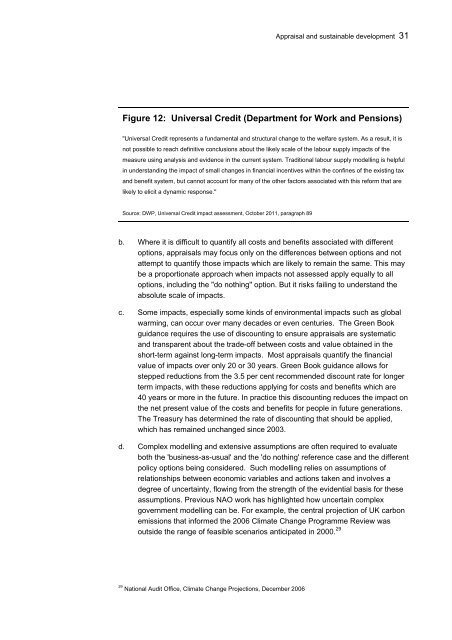Full report (pdf - 1148KB) - National Audit Office
Full report (pdf - 1148KB) - National Audit Office
Full report (pdf - 1148KB) - National Audit Office
You also want an ePaper? Increase the reach of your titles
YUMPU automatically turns print PDFs into web optimized ePapers that Google loves.
Appraisal and sustainable development 31Figure 12: Universal Credit (Department for Work and Pensions)"Universal Credit represents a fundamental and structural change to the welfare system. As a result, it isnot possible to reach definitive conclusions about the likely scale of the labour supply impacts of themeasure using analysis and evidence in the current system. Traditional labour supply modelling is helpfulin understanding the impact of small changes in financial incentives within the confines of the existing taxand benefit system, but cannot account for many of the other factors associated with this reform that arelikely to elicit a dynamic response."Source: DWP, Universal Credit impact assessment, October 2011, paragraph 89b. Where it is difficult to quantify all costs and benefits associated with differentoptions, appraisals may focus only on the differences between options and notattempt to quantify those impacts which are likely to remain the same. This maybe a proportionate approach when impacts not assessed apply equally to alloptions, including the "do nothing" option. But it risks failing to understand theabsolute scale of impacts.c. Some impacts, especially some kinds of environmental impacts such as globalwarming, can occur over many decades or even centuries. The Green Bookguidance requires the use of discounting to ensure appraisals are systematicand transparent about the trade-off between costs and value obtained in theshort-term against long-term impacts. Most appraisals quantify the financialvalue of impacts over only 20 or 30 years. Green Book guidance allows forstepped reductions from the 3.5 per cent recommended discount rate for longerterm impacts, with these reductions applying for costs and benefits which are40 years or more in the future. In practice this discounting reduces the impact onthe net present value of the costs and benefits for people in future generations.The Treasury has determined the rate of discounting that should be applied,which has remained unchanged since 2003.d. Complex modelling and extensive assumptions are often required to evaluateboth the 'business-as-usual' and the 'do nothing' reference case and the differentpolicy options being considered. Such modelling relies on assumptions ofrelationships between economic variables and actions taken and involves adegree of uncertainty, flowing from the strength of the evidential basis for theseassumptions. Previous NAO work has highlighted how uncertain complexgovernment modelling can be. For example, the central projection of UK carbonemissions that informed the 2006 Climate Change Programme Review wasoutside the range of feasible scenarios anticipated in 2000. 2929<strong>National</strong> <strong>Audit</strong> <strong>Office</strong>, Climate Change Projections, December 2006

















